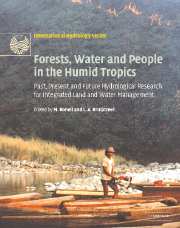 Forests, Water and People in the Humid Tropics
Forests, Water and People in the Humid Tropics Book contents
- Frontmatter
- Contents
- List of contributors
- Foreword
- Preface
- Acknowledgements
- Symposium and Workshop
- Introduction
- Part I Current trends and perspectives on people–land use–water issues
- Part II Hydrological processes in undisturbed forests
- Part III Forest disturbance, conversion and recovery
- 19 Natural disturbances and the hydrology of humid tropical forests
- 20 Spatially significant effects of selective tropical forestry on water, nutrient and sediment flows: a modelling-supported review
- 21 Effects of shifting cultivation and forest fire
- 22 Soil and water impacts during forest conversion and stabilisation to new land use
- 23 Large-scale hydrological impacts of tropical forest conversion
- 24 Forest recovery in the humid tropics: changes in vegetation structure, nutrient pools and the hydrological cycle
- 25 The hydrological and soil impacts of forestation in the tropics
- 26 The potential of agroforestry for sustainable land and water management
- Part IV New methods for evaluating effects of land-use change
- Part V Critical appraisals of best management practices
- Conclusion: Forests, water and people in the humid tropics: an emerging view
- Plate section
- References
20 - Spatially significant effects of selective tropical forestry on water, nutrient and sediment flows: a modelling-supported review
from Part III - Forest disturbance, conversion and recovery
Published online by Cambridge University Press: 12 January 2010
- Frontmatter
- Contents
- List of contributors
- Foreword
- Preface
- Acknowledgements
- Symposium and Workshop
- Introduction
- Part I Current trends and perspectives on people–land use–water issues
- Part II Hydrological processes in undisturbed forests
- Part III Forest disturbance, conversion and recovery
- 19 Natural disturbances and the hydrology of humid tropical forests
- 20 Spatially significant effects of selective tropical forestry on water, nutrient and sediment flows: a modelling-supported review
- 21 Effects of shifting cultivation and forest fire
- 22 Soil and water impacts during forest conversion and stabilisation to new land use
- 23 Large-scale hydrological impacts of tropical forest conversion
- 24 Forest recovery in the humid tropics: changes in vegetation structure, nutrient pools and the hydrological cycle
- 25 The hydrological and soil impacts of forestation in the tropics
- 26 The potential of agroforestry for sustainable land and water management
- Part IV New methods for evaluating effects of land-use change
- Part V Critical appraisals of best management practices
- Conclusion: Forests, water and people in the humid tropics: an emerging view
- Plate section
- References
Summary
INTRODUCTION
Selective forestry is a set of commercial forestry practices that involves the selective removal of particular trees within an ‘annual logging coupe’ of forest (Conway, 1982). Selective harvesting within ‘natural forests’ (i.e. those forests that have not been clearfelled for non-forest uses or converted to plantation or agroforestry) covers a very wide range of practices, including highlead and tractor yarding, harvesting of only large, commercial trees, protection of riparian vegetation along rivers and protection of forest on very steep hills. As a consequence, the intensities of the impacts on the water environment (i.e. water, nutrient and sediment systems) are expected to be very varied. Some of these impacts can be profound. One of the most significant environmental impacts of all types of forestry operations within the humid tropics is accelerated soil erosion (Bruijnzeel, 1992). The resultant input of sediments into rivers leads to damage to fish populations (Martin-Smith, 1998), reduced quality of water supplies, reductions in channel capacity which affects flood risk and boat traffic (Sheffield et al., 1995), and the inundation of offshore corals (MacDonald et al., 2001).
Development of selective harvesting techniques when applied to natural forests in the tropics are currently being focused on so-called ‘Reduced-Impact-Logging’ (RIL) or ‘closely supervised’ methods which aim to improve the ‘sustainability’ of timber production and reduce wider environmental damage.
- Type
- Chapter
- Information
- Forests, Water and People in the Humid TropicsPast, Present and Future Hydrological Research for Integrated Land and Water Management, pp. 513 - 532Publisher: Cambridge University PressPrint publication year: 2005
References
- 2
- Cited by


